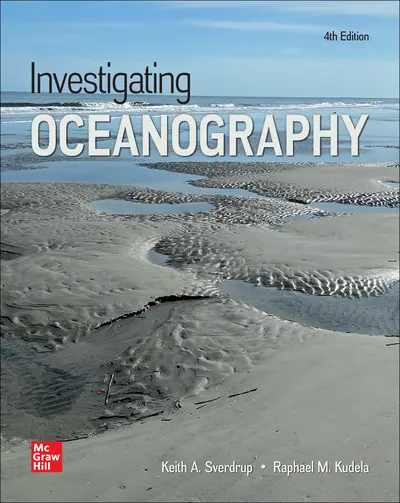My Account Details

ISBN10: 1266632123 | ISBN13: 9781266632129

* The estimated amount of time this product will be on the market is based on a number of factors, including faculty input to instructional design and the prior revision cycle and updates to academic research-which typically results in a revision cycle ranging from every two to four years for this product. Pricing subject to change at any time.
Instructor Information
Quick Actions (Only for Validated Instructor Accounts):
Investigating Oceanography is an introductory oceanography text is intended to teach students the tremendous influence oceans have on our lives. They are encouraged to look at oceanography as a cohesive and united discipline rather than a collection of subjects gathered under a marine umbrella. Investigating Oceanography teaches students about the historical, geological, physical, chemical and biological characteristics of the ocean environment using remarkable images and photos. The authors have incorporated essays written by several scientists discussing topics in their fields of specialization. In addition to understanding processes and principles, the authors believe students must have a basic command of the language of marine science in order to understand the constant barrage of information concerning our planet and marine issues. By the end of this course, the authors want students to be prepared for future environmental discussions and the ability to make decisions as informed global citizens.
Prologue: The History of Oceanography 1 The Water Planet 2 Earth Structure and Plate Tectonics 3 The Sea Floor and Its Sediments 4 The Physical Properties of Water 5 Seawater 6 The Atmosphere and the Oceans 7 Ocean Structure and Circulation 8 The Waves 9 The Tides 10 Coasts, Beaches, and Estuaries 11 The Living Ocean 12 The Plankton, Energy, and Food Webs 13 The Nekton: Swimmers of the Sea 14 The Benthos: Living on the Sea Floor 15 Environmental Issues 16 The Oceans and Climate Disruption
2 Earth Structure and Plate Tectonics 3 The Sea Floor and Its Sediments 4 The Physical Properties of Water 5 Seawater 6 The Atmosphere and the Oceans 7 Ocean Structure and Circulation 8 The Waves 9 The Tides 10 Coasts, Beaches, and Estuaries 11 The Living Ocean 12 The Plankton, Energy, and Food Webs 13 The Nekton: Swimmers of the Sea 14 The Benthos: Living on the Sea Floor 15 Environmental Issues 16 The Oceans and Climate Disruption
4 The Physical Properties of Water 5 Seawater 6 The Atmosphere and the Oceans 7 Ocean Structure and Circulation 8 The Waves 9 The Tides 10 Coasts, Beaches, and Estuaries 11 The Living Ocean 12 The Plankton, Energy, and Food Webs 13 The Nekton: Swimmers of the Sea 14 The Benthos: Living on the Sea Floor 15 Environmental Issues 16 The Oceans and Climate Disruption
6 The Atmosphere and the Oceans 7 Ocean Structure and Circulation 8 The Waves 9 The Tides 10 Coasts, Beaches, and Estuaries 11 The Living Ocean 12 The Plankton, Energy, and Food Webs 13 The Nekton: Swimmers of the Sea 14 The Benthos: Living on the Sea Floor 15 Environmental Issues 16 The Oceans and Climate Disruption
8 The Waves 9 The Tides 10 Coasts, Beaches, and Estuaries 11 The Living Ocean 12 The Plankton, Energy, and Food Webs 13 The Nekton: Swimmers of the Sea 14 The Benthos: Living on the Sea Floor 15 Environmental Issues 16 The Oceans and Climate Disruption
10 Coasts, Beaches, and Estuaries 11 The Living Ocean 12 The Plankton, Energy, and Food Webs 13 The Nekton: Swimmers of the Sea 14 The Benthos: Living on the Sea Floor 15 Environmental Issues 16 The Oceans and Climate Disruption
12 The Plankton, Energy, and Food Webs 13 The Nekton: Swimmers of the Sea 14 The Benthos: Living on the Sea Floor 15 Environmental Issues 16 The Oceans and Climate Disruption
14 The Benthos: Living on the Sea Floor 15 Environmental Issues 16 The Oceans and Climate Disruption
16 The Oceans and Climate Disruption
Accessibility
Creating accessible products is a priority for McGraw Hill. We make accessibility and adhering to WCAG AA guidelines a part of our day-to-day development efforts and product roadmaps.
For more information, visit our accessibility page, or contact us at accessibility@mheducation.com
Affordability
Reduce course material costs for your students while still providing full access to everything they need to be successful. It isn't too good to be true - it's Inclusive Access.
Need support? We're here to help - Get real-world support and resources every step of the way.